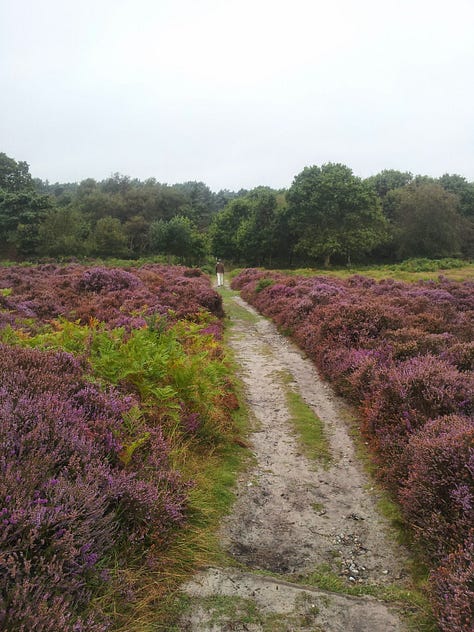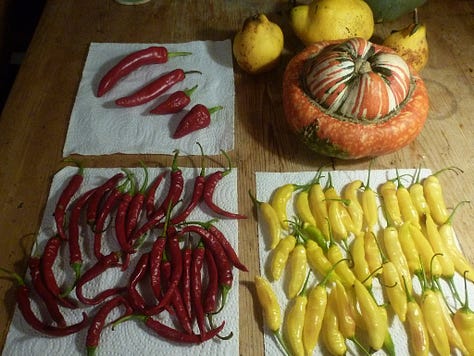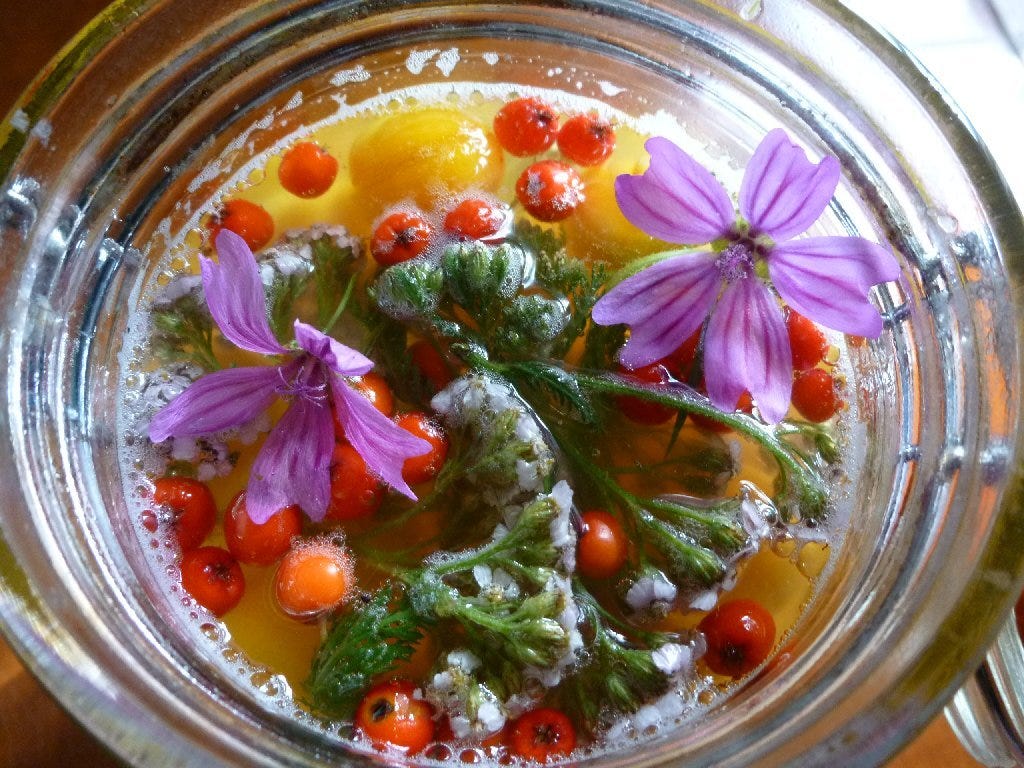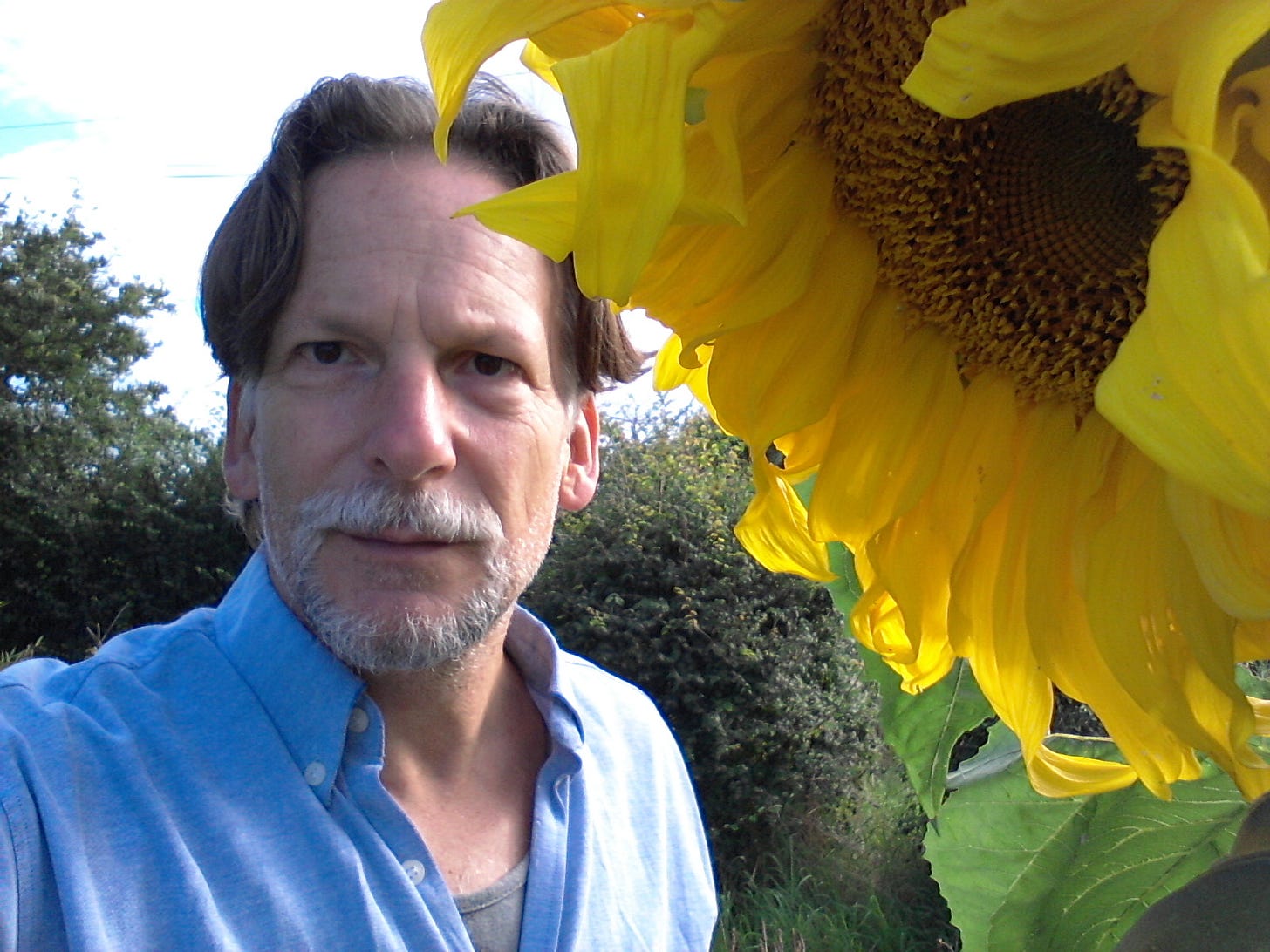Step into this summer night: there’s a warm south wind blowing in the birch trees, the sky above you is full of stars. You can hear the sea roaring in the distance. You walk barefoot down the path, past the dark rustling sunflowers, through the long grass, to a hammock under buddleia bushes. Lie here, and look up into the glittering bowl of sky. Wait. Wait some more. Don’t fall asleep. There! Did you see it? That incandescent stream of light? And then, look, another, over there!
It’s the Perseids, a meteor shower of falling stars that comes every year, now at the peak of high summer. Like a child, you cry out, clap your hands, as each one appears miraculously out of the dark, and you make a wish. So many wishes, that are one really. Let there be more.
Visiting and dreaming
‘I’ve come to the conclusion that it’s all about visiting and dreaming’ Mark told me week before he died. I thought he was referring to the ‘tech’ of our plant practice, but looking back, maybe he meant it was way of looking at everything we do, The rise and fall of our lives. How the solar year turns, and we turn with it. We think it is all about the visit, the engagement, and then there is a switch of focus, of mood. Emerging from the roots of winter solstice, all the leafy energy of ourselves races towards the light of midsummer. At the sun’s zenith, we flower; and afterwards, as the pace slows, we fruit, go to seed, fall back, go inwards into the dark again, and dream.
Since the spring, I have realised so many things that Mark embodied, in way I could not do before in the hurly burly of life. Memories that are pin-sharp about the flowers and trees we sat with return to me as I revisit them, layered like leaves in time: the harebells shaking on the dunes, the scent of heather on the heath, the golden spikes of agrimony on the waysides, the mighty angelica rising on the riverbanks. It’s as if Mark’s life itself was a visit, and now I’m living the dreaming of things. It’s not what I want but it’s something I can do, a way that makes sense of what is, a way to honour his life, our life, and, most of all, to honour the places and the plants that taught us everything about being fully alive here now. It steadies the loss, the wish that he was still here, and pivots me to this change of attention. Lughnasadh is where it begins.
The downshift
Lughnasadh (1st/2nd August) is perhaps the least known of the eight ancestral fires of the year. Perhaps because it is freer from traditional associations than the others, it feels the most open. Carrie came back for a visit before her autumn travels, and we went swimming that evening at Sizewell. The sea was big and rough and full of young men leaping in the waves, high above the sandbanks. We joined them, laughing. It felt good to be in there with all that movement. Later we raised our glasses to this time of harvest, to Mark, to the sea, with a blackcurrant and fennel flower mead I had made, and lit a crow’s nest fire of sticks. A heron flew close towards us and then swerved away; you could hear the distant thunder of the combines gathering barley and beans in the fields around the house.
The next morning we rose at dawn and went to Dunwich Heath, walking through the mist and birch woods, across the heath now purple with bell heather and ling, down to the cliffs where months before we had sat just as the sand martins had arrived.
It’s a moment you wait for with baited breath, knowing that this is a marker time, when you step through a door, shed part of yourself, like a petal, to become a fruit.
The sun rose, a slow scarlet ball out of a shifting luminous sea. The was a great silence, a pause. And then we went into the shiny red-gold water, swimming in the path of the sun. Some part of me wished I could carry on home down that solar path of fire.
When I began this column I wrote the Red Tent would be an existential space to explore ‘the solarising rubedo stage of alchemy’. Alchemy is one of those exciting words, that can gets mired in arcane and esoteric fancies, and not make it into ordinary life. But practical metaphysics, embodying change, making gold out of dross from all our encounters and relationships, is what counts on this Earth. One of its principles is that, in order to change, the past has to be relinquished to feed the future. To weather collapse, our own and the world’s, is to understand that collapse is part of a system, part of Earth’s metabolics. It is to understand that the downswing work begins in here at Lughasadh, in the days named after the dog star Sirius that reappears at this time, when the birds stop singing and the land is burnished, seedy and dry, when the fruit begins to ripen in the scratchy hedgerow. When, you realise that there is more behind you, than lies ahead. You think being here is all about your flowering, your visit, when in fact it’s about the seed, what needs to stored up for the future, your sweetness held like honey in a hive, so life can continue.
Rubedo is the action of the sun on your being. And the heat that allows certain processes to take place. The herbal mead elixir (see above) is an alchemical drink because it is fermented, but also is a real life metaphor for the transformation we need to undergo to become properly human, not just another cog in the wheel of Empire: where the sweetness of the honey ferments and become the medicine, alongside the fruit and flowers. The various stages that break the ingredients down is the work of invisible actors. When these stages are complete, what remains in the alchemical jar is another being altogether. The raw has become ‘cooked’.
We don’t have these solar/earth transformations written into our culture. Everything after the zenith is understood as failure, loss, decrepitude. In times of difficulty, we have problem solving and psychology and gods who demand our fealty. We would rather play with idea of alchemy in our minds, than let it do its uncomfortable work in our hearts and souls. But these stages, whatever names you call them, whatever myth or metaphor is your guiding star, are real things you need to undergo. When you make a mead you need to use unprocessed ingredients: the honey has to be raw, the water has to be spring water; the fruit needs yeast left on its skin, so that the micro-organisms that create fermentation can do their work. We need to gather the undoctored parts of ourselves together in a hermetic space. And then open, and wait.
That’s the pause.
We wait in the pause for something to occur. By the plant, under the starry sky, this solar vigil by the sea. Your mind struggles to control this space, to make meaning, but the pause state is about letting something in you do not know, a small spark of eternity in our human earth time. The question is can we endure this heat, this dryness, this itchy, oppressive sun-burdened time the ancients felt was malevolent. Have we enough patience, enough courage, to allow that quicksilver shift to happen, to start the next stage of the ferment: the breakdown.
Years ago, Mark and I had sat on the shore, further down the coast, at Lughnasadh, realising we had come to the end of a road. The book I wrote about our plant practice ends with that swim towards the rising sun that mirrored what I had once called the solar path: a journey about becoming a real human being, guided by 52 wild and medicine flowers. We didn’t know what lay ahead, but it marked a time when our attention would move from an individual enquiry into a community practice. I don’t know what lies ahead now either, but I can see the red and gold path that leads across the water to the sun.



Mr Felton and the butterflies
Sometimes you meet an old guardian of a place and they open a door into the land you didn’t know was there. Mr Felton is a forester and used to deliver firewood to us, before we learned to forage for our own. He would tell us about the purple emperor butterflies he helps propagate. We gave him some cuttings from our massive buddleia that one miraculous sunny day had hosted over 200 butterflies.
This spring as I was cycling past Theberton Woods, I saw him, staring intently into some roughly felled brushwood. He was looking for butterfly orchid rosettes. He used to manage these woods (now owned by a European bio-fuel company) and defends any incursion into them like a bristly badger. But that day he showed me where all the orchids – early purple to bird’s nest – could be found.
This July I went to back to find him. A small group of people were sitting on chairs in a clearing, staring upwards, looking for the dance of the purple emperors among the oak canopy. In between sightings he showed us the cocoons of hawkmoths and brimstone butterflies he had rescued from a nearby hedge before it was flailed. You could hardly distinguish them from the twigs in their strange and brilliant disguises.
How must it be, I wondered, to wait inside one of those cocoons as your caterpillar body dissolves and you become another creature entirely?
You might ask: why are we looking at butterflies in a time of emergency, are there not bigger matters at hand? Because if you want to understand the natural alchemy of this Earth, why lying alongside plants until your mind cedes governance to the heart is crucial, you need to know that change happens in the small places, with these small alliances: the shooting star that opens up the universe, the miniscule mushroom that converts sugar to alcohol. The lighting of a fire and the witnessing of a sunrise. These things stop a world going the way of entropy and insure regeneration.
In a bad time for butterflies, I remember Mr Felton: how he looks for threatened butterfly eggs, so he can nurture them through winter and return them to the goat willows in spring. In a mean-spirited time, I remember the country people who put garden produce out in wooden stalls along these Suffolk back roads, with their eggs and flowers, plums and courgettes, a jam jar or old biscuit tin for coins: Malcolm and Eileen, Paula and Barbara and Daphne, the man with giant onions, the farmer with a trailer of Brussel sprouts, whose names we never knew. And David Moyse, steeple keeper and history man of the village, who lived at the head of our lane and made us welcome, who gave us his green tomatoes for chutney. These things do not count in the power-obsessed world of podiums and stadiums, but in the dreaming they count for everything. When the people are no longer here, when that stall disappears, it feels, as if a ship has become unmoored, that the best reasons for living in a place have gone.
Except that they have left something behind that you now hold: a key in your metaphysical hands.
The metaphysical larder



One of the key shapes in both the Labyrinth work and in the Uneasy Chair practice makes a figure of eight, or lemniscate in space-time, and shows us how we can keep in balance with this living breathing Earth. How the gathering of material and returning with gifts ties us into a feedback loop that allows life to continue. It is a shape the honeybees dance to show their sisters where the nectar and pollen can be found, according to the direction of the sun. You set out, you encounter, you return and you give back. In a grab-all-you-can-and-keep-it culture, that return is entirely missing. Lughnasadh, properly met, is a reminder to share the bounty.
Mark didn’t keep a stall outside the gate, or guard a wood, or but he did embody the heart and soul of a future being, a man who would lie down in the heather in the dog days and practice the art of ‘radical relaxation’, who would make fritters from mallow leaves for whoever came to visit, and grow sunflowers wherever he could. I don’t have runner beans to share either, but I do have a tool shed stocked with all the practices we created together, the memories of how Mark was in the world. That is our store. That’s what I can give back.
It is no accident that the summer holidays, the times of gathering, reconfiguring and rest, come at the end of the agricultural growing cycle. This metaphysical pause at harvest, however, is not in order to return to the world of production in better shape, but to engage in another relationship with life. A lot of Mark’s teaching was simply about making time and space to foster this relationship – with the Earth, the sun, to time and your own physical being – ignored in the unkind rush of ‘progress’. To endure the wait, in spite of the harrying mind, and allow what you do not expect, the butterfly, the shooting star, the future, to appear, as if from nowhere.
So, in the spirit of Lughnasadh, to celebrate the fruits of the collaboration of sun and Earth, here is perhaps the premier tool from our practices, the methods of visiting and dreaming, or ‘how to hang out with plants’. It is extracted from Mark’s piece in Issue 24 –Eight Fires and will appear in the small book about his work I compiled last month (to be published this October).
TUNING IN TO PLANTS and TREES
You can do this exercise alone, although I find it works better with a partner or a small group (up to four people). If you’re with others, you can work with the same plant or different ones, whichever you (or the plants) decide.
There are three parts to this technique: first you go out to visit the plant or tree in the land you are in (making sure you go beyond your garden to somewhere that is not under your aegis or control). Then you return home and revisit the event in your imagination. Thirdly you put the experience into a creative form, a piece of writing, a drawing, even a dance or song. The whole process can take several hours, so give yourself enough time with no other distractions.
The visit
In the territory you are working with, go out and find a wild plant or tree you resonate with or feel a pull towards. If you don’t know what it is, don’t worry about identifying it – some of the deepest connections with plants can happen before you know what their names are – and resist any temptation to take photographs. The initial experience should be a direct connection between you and the plant and not be mediated by tech. You can photograph and identify the plant at a later time if necessary.
A gentle word of advice here: touch the plant only if you know for certain it is not poisonous and you feel invited to do so. Treated with respect, poisonous plants can turn out to be the best of teachers and companions, but you don’t want to be handling them or putting them in your mouth!
Sit down next to the plant and greet it as a fellow inhabitant of the place. Take a few deep breaths and focus your awareness on your feet until you can feel them tingle. Then become aware of the surroundings that you and the plant/tree are within and a part of. The season, the air, any sounds. Take notice of everything that’s happening.
Get a sense of what the plant’s intelligence might be and what it might be relaying to you. Let yourself become conscious that plants are aware of you as much as you are of them. You are not alone. Let your awareness expand into the surroundings and feel how much life is around you. Notice how your body is responding. Your feelings. If your mind gets distracted with interfering thoughts or a desire to get up or escape, bring yourself back with gentle deep breaths and sit with it, including (especially!) any discomfort.
Stay for at least 25 and up to 40 minutes, then thank the plant or tree (‘Great to meet you’ works well) before you head back home.
I call this process sitting down alongside with, as it gives a sense of both you and the plant as fellow planetary beings within the territory.
Revisiting the plant or tree in your imagination (visioning)
Find a quiet place indoors to lie down and relax with no distractions. Close your eyes, take some deep breaths and revisit the experience with the plant in your imagination. Be open to what emerges without judging and trying to get anything right. Be aware of any messages or ‘medicine’ the plant may be relaying to you – these may come in the form of physical sensations or memories, be verbal, visual or on a feeling level. The plants can even reveal themselves as ‘human’, animal or in other forms, and they can also be very humorous. After 20 minutes or so, thank the plant and bring yourself back to the room.
After the session, take notes and/or make drawings. If you are working with others, take turns to give testimony to your experiences and listen to each other. Over the next few days, pay attention to any dreams where the plant might appear. Visit the plant again, and identify it if need be. Immerse yourself in the whole experience. Connecting with plants in this way can have an impact much beyond the actual time you spend doing the exercise.
Thanks for reading everyone. I wish you all a very good high summer and hope to be back at the end of the month with the next step of The Labyrinth and the Dancing Floor.







So many fruits and seeds in this, thank you for sharing of your and Mark’s storehouse of wisdom. I particularly love your mead metaphor’s and so want to try your late summer Mead!
My partner has been a mead maker for years too and seems similarly attuned, she labels the meads she makes and bottles “Chrysopoeia”.
Lastly, thank you for this bit in particular:
“Alchemy is one of those exciting words, that can get mired in arcane and esoteric fancies, and not make it into ordinary life. But practical metaphysics, embodying change, making gold out of dross from all our encounters and relationships, is what counts on this Earth. One of its principles is that in order to change, the past has to be relinquished to feed the future.”
I’ve felt mired in the putrefaction of Nigredo for so long, have so much dross to burn off, that I think I expected some miraculous change to know that a clearly marked line had been crossed and that it was over. Yet it’s in the small things, the argument you don’t need to have, the offense you let slide and don’t react to, the loosening of the need to not be right, and that shift you mention toward community rather than our individual selves.
Thank you 🙏
So much within your words here, both said and unsaid, touched me deeply. Thank you, Charlotte.